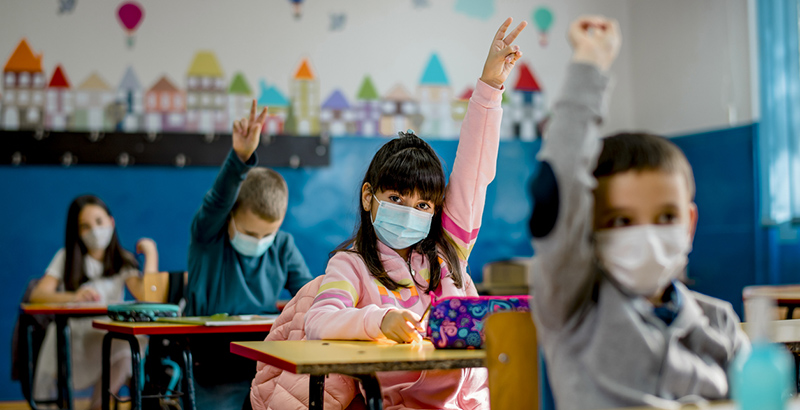This Week in School Reopenings: Students’ Return To Classrooms Slows, 1 in 3 Districts Expand Summer Learning & More Key Updates

Get essential education news and commentary delivered straight to your inbox. Sign up here for The 74’s daily newsletter.
As the weather turns sunny across much of the country and students and teachers alike find their minds wandering to summer, school districts, too, are mulling what the warmer months will bring.
Seventy percent of the top 200 school districts nationally have announced their summer learning plans, and over one third include significant expansions from last year, according to a recent update.
Meanwhile, as the academic year winds down, students’ return to classrooms appears to have leveled off, with schools’ attention instead going toward planning what’s to come next fall.
Here’s what you need to know about the state of play on school reopenings across the nation, powered by data and insights from the school calendar tracking website Burbio.
1 School reopenings level off
After steady declines in remote-only schooling since President Biden took office, reopenings have slowed with only slight changes from last week.
The share of schools offering daily in-person learning barely budged, climbing from 67 to 68 percent, while schools operating on a hybrid model notched down slightly, falling from 30 to 29 percent. The proportion of virtual-only schools held steady at 3 percent.
But as has been the case throughout the spring, reopening does not imply a return to in-person instruction for all students, as large shares of parents opt to keep their children learning from home, especially in population-dense urban areas.
In Chicago, for example, when high schools opened their doors last month, buildings remained unusually empty — with as few as one student in some classrooms. And as Los Angeles high schools have returned for in-person learning, just 7 percent of students are attending reopened classrooms.
2 Over 1 in 3 districts expanding summer learning
More than one-third of the districts tracked by Burbio that have announced their summer learning plans will be expanding their offerings.
Washington D.C., for example, is adapting its famed summer jobs program to offer stipends for high schoolers looking to take classes in June and July.
The trend reflects many observers’ hope that as coronavirus cases continue to fall in the U.S. and eligibility for vaccines continues to expand, the summer will be an opportunity for accelerated learning after a disrupted academic year.
Still, some experts remind officials that summer break holds another sacred promise: fun.
While learning should be a priority this summer, many children are understandably exhausted after a year like no other. Programming should emphasize outdoor activities, socializing and field trips to re-engage kids and set them up for success next fall, researchers at Georgetown’s FutureEd think tank argue.

3 Districts plan virtual school options for fall
In previous school reopening updates, The 74 has tracked states and districts as they launch virtual academies for 2021-22.
More districts joined the list this week, rolling out remote learning opportunities of their own.
Columbus, Ohio announced a K-12 virtual academy that will be able to accommodate 2,000 learners next fall. St. Louis, Missouri will offer a remote option for K-6 in the fall, while older students retain the option to enroll in a statewide online program. And Garden Grove, California will also launch its own virtual school, though like Columbus, officials note that “space is limited.”
While acknowledging the importance of remote learning through the pandemic, U.S. Education Secretary Miguel Cardona stressed his preference for students to be back in classrooms, cautioning that districts should not over-rely on virtual options next year. That starts with making sure schools meet the needs of all learners, he said while speaking to the Education Writers Association last week.
“What I don’t want, to see to be very candid with you, is a system where students who were underserved in the past select remote learning because they don’t feel that [their] school is welcoming or safe for them,” said the education secretary. “We need to make sure all students prefer to learn in the schoolhouse because it’s a warm place for them, it’s a welcoming place, they see people that look like them.”
4 Ed Department seeks to build trust in reopening by engaging families
Cardona also said last week he wants “families at the table” as schools prepare for the fall, The 74’s Linda Jacobson reports.
The words come as welcome news to parents who have felt shut out of efforts to help their children recover from the pandemic.
In April, Education Department officials met with Keri Rodrigues, founding president of the National Parents Union, a network of advocacy groups that has been critical of distance learning, especially for low-income youth and students of color, and has pushed for schools to reopen.
“They feel like we represent a really important constituency,” Rodrigues said. “We were very clear with them. We’re not here just to be disseminating information from [the department]. We need to be informing policy.”
5 4-day weeks restrict learning
As a pandemic precaution, thousands of school districts — even those that have “fully” reopened — are operating on four-day schedules to leave buildings empty once a week for cleaning. Skeptics, however, believe the sanitation measures may be unnecessary for preventing a mostly airborne virus while robbing students of valuable in-person learning time.
Now the numbers are in, and the results are stark. Schools that cut instructional time by switching to four-day schedules, even pre-pandemic, saw meaningful reductions in student learning, The 74’s Kevin Mahnken reports.
The results indicate that, even amid worry for transmission of COVID-19, schools should emphasize mask-wearing and ventilation, which need not restrict learning time, over school-wide sweeps for disinfection.
“If you’re losing instructional time year over year, that learning loss is growing over time,” said Oregon State University economist Paul Thompson.
Help fund stories like this. Donate now!

;)
